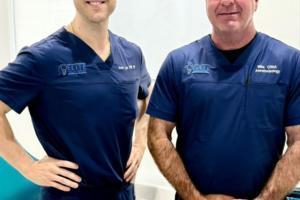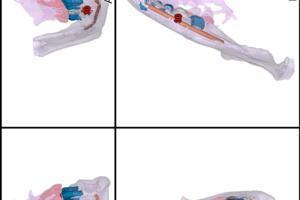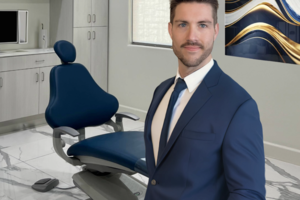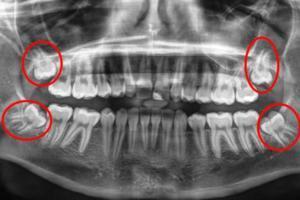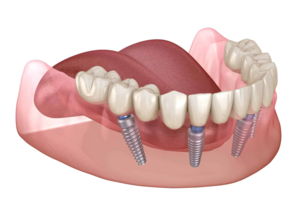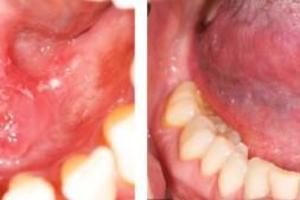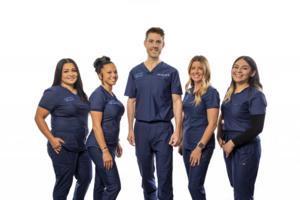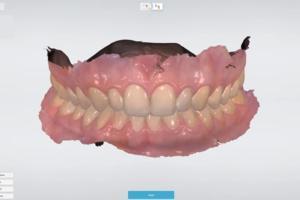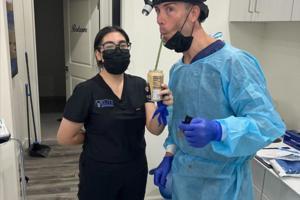![]() EXPERT
EXPERT
Jeremy Egan
Dentist
Dr. Egan’s advanced credentials include completing a six-year Oral Maxillofacial Surgery Residency, where he gained specialized experience in facial trauma repair, orthognathic (jaw) surgery, and complex dental implants. In addition, he earned his MD at the esteemed Jacobs School of Medicine at the University at Buffalo and furthered his surgical expertise with intensive training in general surgery. Dr. Egan’s commitment to excellence has established him as a leader in the field, and he is renowned for advanced surgical techniques, including bone grafting, sinus lifts, and All-on-4 dental implant restorations, that restore both function and aesthetics for his patients.
At Elite Oral and Maxillofacial Surgery, Dr. Egan’s expertise in anesthesiology ensures patient comfort and safety during all procedures, whether routine or highly complex. His patient-centered approach prioritizes each individual’s well-being and peace of mind, creating a reassuring experience from consultation to post-operative care. Elite Oral and Maxillofacial Surgery has become Tulsa’s trusted destination for patients seeking life-changing jaw surgery, precise facial trauma repair, and leading-edge dental implant solutions.
Recognized with numerous awards for his research and surgical innovations, Dr. Egan stands out as a member of the American College of Physicians, the American Medical Association, and the American Board of Oral and Maxillofacial Surgery. His dedication to continual learning and innovation allows him to stay at the forefront of surgical advancements, ensuring Tulsa patients receive the most up-to-date care available.
Dr. Egan’s commitment to his patients extends beyond his surgical skill. He is deeply involved in his community and enjoys spending time with his family and pursuing creative hobbies, building lasting connections with his patients and fellow Tulsa residents. His philosophy of care emphasizes respect, open communication, and the highest standards of surgical excellence.
For those seeking trusted, expert oral and maxillofacial care in Tulsa, Dr. Jeremy Egan, DMD, MD, and the team at Elite Oral and Maxillofacial Surgery are committed to providing compassionate care that truly makes a difference. With a focus on patient comfort, safety, and exceptional outcomes, Elite Oral and Maxillofacial Surgery is Tulsa’s leading destination for specialized oral surgery solutions.
- Tulsa, OK
- State University at New York
- Accepting new patients
“Why Our Dental Implant Outcomes Set the Standard in Oklahoma: From 3D Imaging to Surgical Precision.
Introduction: Precision Isn’t Optional—It’s the StandardDental implants aren’t just another service we offer at Elite Oral and Maxillofacial Surgery of Oklahoma—they’re one of...
The Greatest Investment: Why Medical & Surgical Mission Trips Are a Moral Imperative
In today’s fast-paced, profit-driven world, it’s easy to forget the faces of those quietly suffering in silence. I’ve seen them. Held their hands. Looked into their eyes and witnessed...
Teeth, Trust, and Tulsa: Why Full-Arch Dental Implants (and Wisdom Teeth Removal) Deserve a Surgeon With an MD and a DMD
Let’s get one thing straight: no one wakes up excited to hear the words "oral surgery. " I’ve yet to meet someone who fist-pumped in the mirror because they needed all their teeth...
What to Expect After Oral Surgery: Healing Tips from Dr. Jeremy Egan, DMD, MD
When it comes to oral surgery, knowing what to expect afterward can be just as crucial as understanding the procedure itself. I’m Dr. Jeremy Egan, a dual-degreed Oral and Maxillofacial...
Unreasonable Hospitality in Surgery: How Our Culture Drives Elite Patient Experiences
When people think of surgery, they often picture cold, sterile rooms and clinical conversations filled with jargon. But I believe that surgical care should be something entirely...
The Future of Oral Surgery in Private Practice: Become the “CEO of the Surgical Experience” and Innovator of the Profession!
Let’s talk about the future of oral surgery—and no, I’m not referring to comfier waiting room chairs or slightly fancier décor. I’m talking about a future where private practice...
Why Our Dental Implant Outcomes Set the Standard in Oklahoma: From 3D Imaging to Surgical Precision.
Introduction: Precision Isn’t Optional—It’s the StandardDental implants aren’t just another service we offer at Elite Oral and Maxillofacial Surgery of Oklahoma—they’re one of...
Why I chose to Serve Tulsa, Oklahoma: A letter from Dr Jeremy Egan, DMD MD
Introduction: Finding Home in TulsaIf you had told me years ago that I would one day be planting roots in Tulsa, Oklahoma, I probably wouldn’t have believed you. Growing up in...
Top 10 Signs You Should Visit an Oral and Maxillofacial Surgeon
Let’s face it—life gets busy, and oral health sometimes takes a backseat to work, family, and everything in between. But your mouth is more than just the gateway to your morning...
WHY YOU SHOULD CHOOSE ELITE ORAL AND MAXILLOFACIAL SURGERY FOR DENTAL IMPLANTS IN TULSA, OKLAHOMA
Are you considering dental implants and searching for the best oral surgeon in Tulsa, OK? Dental implants are a life-changing solution for missing teeth, but it’s crucial to select...
EXPERT WISDOM TEETH EXTRACTIONS IN TULSA, OK: WHY ELITE ORAL AND MAXILLOFACIAL SURGERY IS THE BEST CHOICE
If you're experiencing pain or discomfort from your wisdom teeth, it's time to consider having them removed by a highly experienced oral surgeon. Wisdom teeth extraction is one...
WHAT IS AN ORAL AND MAXILLOFACIAL SURGEON? MEET DR. JEREMY EGAN, DMD, MD – OKLAHOMA'S TOP ORAL SURGEON
When it comes to oral surgery, you want the best care possible. But what exactly is an oral and maxillofacial surgeon, and how do they differ from a general dentist? If you're...
The Benefits of All-on-4 Dental Implants: A Life-Changing Solution in Tulsa
Missing teeth can affect more than just your smile; they can impact your confidence, ability to eat, and overall oral health. For individuals who are missing multiple teeth or...
What to Expect During Your First Visit to Elite Oral and Maxillofacial Surgery of Oklahoma
At Elite Oral and Maxillofacial Surgery of Oklahoma, we understand that your first visit to an oral surgeon can feel overwhelming. Whether you’re visiting us for wisdom teeth...
The Importance of Oral Cancer Screenings: Risk Factors, Prevention, and Early Detection at Elite Oral and Maxillofacial Surgery of Oklahoma
Oral cancer is a serious and often life-threatening condition that affects thousands of people every year. Early detection and regular screenings can dramatically improve the...
What Sets Elite Oral and Maxillofacial Surgery of Oklahoma Apart from Other Practices?
Let’s face it—no one gets excited about needing oral surgery. But here’s the thing: at Elite Oral and Maxillofacial Surgery of Oklahoma, we believe that just because something...
The Connection Between Oral Health and Overall Health: Why It Matters
We’ve all heard the phrase “you are what you eat,” but did you know that your mouth is a window into the health of your entire body? Yes, we’re talking about oral health—a topic...
A Day in the Life of an Oral Surgeon: Behind the Scenes with Dr. Jeremy Egan, DMD, MD
Ever wondered what a day in the life of an oral and maxillofacial surgeon looks like? I know, it's not exactly the kind of thing you daydream about at work, but trust me, it's...
Top 5 Benefits of All-on-4 Dental Implants Over Traditional Dentures - Dr. Jeremy Egan, DMD, MD
Let’s be real—when it comes to missing teeth, nobody wants to settle for a “so-so” solution. Whether you’re dealing with tooth loss due to age, an accident, or other factors,...
Bone Grafting: How It Can Save Your Smile Before Implants - Dr. Jeremy Egan, DMD, MD
If you’re considering dental implants but have been told you don’t have enough bone to support them, don’t worry—there’s a solution that could make your dream smile possible....
How many implants can you get in one visit?
Factors Affecting the Number of Implants in One Visit
1. Oral and Bone Health
Adequate bone density and quality are essential for successful implant placement. If you have sufficient bone volume, multiple implants can be placed at once. If bone loss is present, a bone graft might be necessary before placing implants, which could extend the overall treatment timeline.
2. Complexity of the Procedure
Placing several implants in one session may require additional time and preparation, especially if the implants are in different areas of the mouth. Dr. Egan will assess the specific locations and any anatomical considerations to determine if all three implants can be placed in a single visit.
3. Patient Comfort and Anesthesia
Many patients are comfortable receiving multiple implants at once under local anesthesia. However, if you feel anxious or if the procedure is extensive, sedation options such as IV sedation are available to ensure a comfortable experience. This can make it easier to place multiple implants in one session without patient discomfort.
4. Healing and Recovery
While placing multiple implants in one session is convenient, it’s essential to follow proper post-operative care. Healing may take a bit longer when multiple implants are placed, as your body will be adjusting to more than one surgical site. Dr. Egan will provide guidance on managing recovery to promote successful healing for all implant sites.
Options for Replacing Multiple Missing Teeth
• Individual Implants for Each Missing Tooth: You can have an implant placed for each missing tooth, which is a straightforward approach, especially if the missing teeth are spread across different areas.
• Implant-Supported Bridges: For adjacent missing teeth, Dr. Egan might recommend an implant-supported bridge, which involves placing two implants to support a bridge that replaces all three missing teeth. This option reduces the number of implants needed and can be more cost-effective while still providing stability.
Typical Number of Implants Per Visit
For patients with good oral health, three implants in one session are generally manageable, and sometimes even more can be placed depending on individual circumstances. Dr. Egan will conduct a thorough evaluation to determine the best approach and make a personalized plan for you.
At Elite Oral and Maxillofacial Surgery of Oklahoma, Dr. Jeremy Egan and his team work to create a comfortable, efficient treatment experience, whether you’re receiving a single implant or several. By addressing all necessary factors, they ensure that you get the best possible outcome in a single visit or over multiple sessions as needed.
Can I smoke with a dental implant?
How Smoking Affects Dental Implants
1. Reduced Blood Flow and Oxygen
Smoking constricts blood vessels, reducing blood flow and oxygen delivery to the surgical site. Blood flow is essential for healing and helps ensure that the implant integrates properly with the jawbone (a process called osseointegration). Reduced oxygen levels slow down healing and increase the risk of complications.
2. Higher Risk of Infection
Smoking weakens the immune system, making it more difficult for your body to fight off bacteria. This can increase the risk of infection at the implant site, which may lead to peri-implantitis (an infection around the implant) and, in severe cases, implant failure.
3. Delayed Bone and Tissue Healing
Successful implant placement relies on the jawbone’s ability to integrate with the implant post. Smoking disrupts the body’s ability to form new bone and gum tissue, which can delay healing and prevent the implant from anchoring securely in the bone.
4. Increased Risk of Implant Failure
Studies show that smokers are at a higher risk of implant failure compared to non-smokers. The combination of reduced blood flow, slower healing, and a higher risk of infection makes it more challenging for the implant to remain stable and healthy.
5. Potential for Gum Recession
Smoking can cause gum tissue to recede, which can expose the metal portion of the implant and compromise its appearance and stability. Recession may also increase the risk of implant failure by reducing the support around the implant.
Tips for Patients Who Smoke and Want a Dental Implant
If you’re a smoker and considering a dental implant, here are some recommendations to support implant success:
• Quit Smoking Before Surgery: Ideally, it’s best to quit smoking altogether, but if that’s not possible, try to stop smoking at least 2-4 weeks before your implant surgery. This allows your body to begin the healing process without the added strain of smoking.
• Avoid Smoking During Healing: After surgery, avoid smoking for at least 2-4 weeks, as this is the most critical period for healing and osseointegration. Dr. Egan can provide specific guidance based on your healing progress.
• Consider Smoking Cessation Resources: If you’re interested in quitting, consider seeking support through smoking cessation programs, counseling, or nicotine replacement options. Quitting will not only benefit your implant but also your overall oral and general health.
Long-Term Care for Smokers with Implants
If you choose to continue smoking, it’s essential to practice excellent oral hygiene and schedule regular follow-ups with Dr. Egan to monitor the implant’s health. However, reducing or quitting smoking remains the best approach for maximizing implant success and longevity.
Dr. Jeremy Egan and the team at Elite Oral and Maxillofacial Surgery of Oklahoma are committed to supporting patients in achieving the best possible outcomes with their dental implants. By reducing or quitting smoking, you can increase the chances of a successful implant and enjoy long-lasting oral health benefits.
Are dental implants on the front painful?
Pain During the Procedure
Local Anesthesia
The implant surgery is done with local anesthesia, which numbs the surgical site completely. You won’t feel any pain during the procedure itself, though you may feel some pressure or movement. For additional relaxation, sedation options are available if you’re anxious about the procedure.
Optional Sedation
Dr. Egan can provide sedation options, such as nitrous oxide (laughing gas) or oral sedation, to help you feel more comfortable and calm during the procedure, making it virtually pain-free.
Post-Operative Discomfort
Mild to Moderate Soreness
After the anesthesia wears off, some mild to moderate soreness or discomfort is normal, especially in the first 24-48 hours. However, most patients find this discomfort manageable with over-the-counter pain relievers, like ibuprofen or acetaminophen.
Swelling and Tenderness
Some swelling and tenderness are common, particularly in the first few days after surgery. Applying ice packs to the area intermittently during the first 24 hours can help reduce swelling and numb the area, providing additional relief.
Pain Management
Dr. Egan will provide specific post-operative instructions and may prescribe medication if needed. Following these instructions closely can help minimize discomfort and speed up your recovery.
Tips for Minimizing Pain and Discomfort
Use Cold Compresses: Apply a cold compress to the outside of your cheek near the implant site for 10-15 minutes at a time to reduce swelling.
Stick to Soft Foods: Avoid hard, crunchy, or sticky foods, especially during the first few days. Soft foods reduce the pressure on the surgical site and make eating more comfortable.
Practice Gentle Oral Hygiene: Brush and floss carefully around the implant area to keep it clean without disturbing the healing site.
Long-Term Comfort
Once healing is complete, a dental implant on a front tooth will feel natural and comfortable, just like a real tooth. Implants are designed to blend seamlessly with your other teeth and provide long-lasting stability without ongoing discomfort.
Dr. Jeremy Egan and the team at Elite Oral and Maxillofacial Surgery of Oklahoma are dedicated to providing a smooth, comfortable implant experience, from start to finish. By following Dr. Egan’s guidance and post-op care instructions, most patients experience minimal discomfort and enjoy a successful, pain-free outcome with their new front tooth implant.
Can you chew gum with implants?
During the Healing Period
Avoid Chewing Gum for the First Few Weeks
During the first few weeks after surgery, it’s best to avoid chewing gum entirely. The implant needs time to bond with the jawbone in a process called osseointegration, and excess pressure or repetitive chewing motions can interfere with this.
Stick to Soft Foods
In the first few days, a soft food diet will reduce strain on the implants and allow them to stabilize. Foods like smoothies, yogurt, and mashed potatoes are ideal for minimizing stress on the surgical sites.
Once Healing is Complete
Chewing Gum in Moderation
After your implants have fully integrated with the bone, which typically takes 3-6 months, chewing gum is generally safe. However, it’s best to chew gum in moderation to prevent unnecessary stress on the implants and surrounding teeth.
Choose Sugar-Free Gum
Sugar-free gum is better for your oral health and helps protect against plaque buildup around the implants and natural teeth. Look for gum with xylitol, which can help reduce bacteria in the mouth.
Monitor for Any Sensitivity
If you feel any discomfort or sensitivity while chewing gum after the healing period, it may be best to avoid it and discuss this with Dr. Egan at your next follow-up.
At Elite Oral and Maxillofacial Surgery of Oklahoma, Dr. Jeremy Egan will provide personalized guidelines on what to eat and how to care for your implants during recovery. Following these recommendations will ensure a smooth healing process, allowing you to enjoy a confident and functional smile with your new implants.
Can you replace all molar teeth with implants?
Options for Replacing All Molars with Implants
Individual Implants for Each Molar
If you’re looking for a solution that closely mimics natural teeth, individual implants can be placed for each missing molar. This approach provides maximum stability and maintains natural spacing, which is especially beneficial for patients with strong jawbone density. However, this can be costly and may require extensive planning.
Implant-Supported Bridges
Instead of placing an implant for each molar, an implant-supported bridge can be a more cost-effective solution. This involves placing fewer implants (typically two) on each side of the arch to support a bridge that replaces multiple adjacent molars. This option provides excellent chewing function and stability with fewer implants.
All-on-4 or All-on-6 Full-Arch Restoration
For patients missing all molars and possibly additional teeth, the All-on-4 or All-on-6 technique can replace an entire arch (upper or lower) with fewer implants. Four to six implants are strategically placed to support a full set of teeth, offering stability and a natural appearance. This option may be ideal if you are missing multiple adjacent teeth or considering a full-arch replacement.
Factors to Consider
Bone Density and Jaw Health
Replacing multiple molars with implants requires adequate bone density in the jaw. Dr. Egan will assess your jawbone health with advanced imaging (such as a 3D cone beam CT scan) to determine whether bone grafting is needed before placing implants.
Cost and Procedure Complexity
Placing individual implants for each molar can be more expensive and time-intensive. Implant-supported bridges and full-arch restorations can reduce the number of implants needed, often making them more affordable while still providing excellent results.
Long-Term Maintenance
Implants are low-maintenance compared to removable dentures, but it’s essential to maintain good oral hygiene and regular dental check-ups to ensure long-term success.
Benefits of Replacing All Molars with Implants
Improved Chewing and Comfort: Implants restore full chewing function, allowing you to enjoy a wider variety of foods without discomfort.
Jawbone Preservation: Implants stimulate the jawbone, helping to prevent bone loss that often occurs after multiple extractions.
Natural Aesthetics and Function: Implants look and feel like natural teeth, offering a permanent, aesthetically pleasing solution.
Dr. Jeremy Egan and the team at Elite Oral and Maxillofacial Surgery of Oklahoma will work with you to create a personalized treatment plan based on your goals, jawbone health, and budget. Whether you choose individual implants, implant-supported bridges, or a full-arch solution, you can regain function and confidence with a strong, natural-looking smile.
Is oral cyst surgery risky?
Potential Risks Associated with Oral Cyst Surgery
Infection
As with any surgical procedure, there is a slight risk of infection at the surgical site. However, this risk is low, especially when proper post-operative care and hygiene are followed. Dr. Egan may prescribe antibiotics to further reduce the risk of infection.
Swelling and Bruising
Mild to moderate swelling and bruising are common following oral cyst surgery. These are natural responses to surgery and usually subside within a few days. Applying ice packs intermittently can help reduce swelling in the first 24 hours.
Bleeding
Some bleeding may occur, especially within the first 24 hours after surgery. This is typically mild and controlled by applying gentle pressure with gauze. Excessive or prolonged bleeding is uncommon but should be reported if it occurs.
Pain or Discomfort
Mild discomfort or pain is normal after surgery. Dr. Egan will provide guidance on pain management, which may include over-the-counter pain relievers or, if necessary, prescribed medication. Following post-op instructions will help keep discomfort to a minimum.
Nerve Damage
In rare cases, if the cyst is located near a nerve, there is a slight risk of temporary or permanent nerve damage, which could cause numbness or tingling in the affected area. Dr. Egan will use precise imaging and techniques to minimize this risk, especially if the cyst is near important nerves.
Recurrence of the Cyst
Although uncommon, some types of cysts can recur after removal. Dr. Egan will carefully remove the cyst to reduce the chances of recurrence and may recommend follow-up monitoring to catch any potential recurrence early.
Steps to Minimize Risks
Pre-Surgical Evaluation
Dr. Egan will conduct a thorough examination and use imaging (such as X-rays or a CT scan) to assess the cyst’s size, location, and proximity to nerves or other structures. This preparation helps ensure safe and precise removal.
Post-Operative Care
Following Dr. Egan’s post-operative instructions, including keeping the surgical site clean, avoiding smoking, and sticking to a soft food diet initially, can help prevent complications and support healing.
Routine Follow-Ups
Regular follow-up appointments allow Dr. Egan to monitor healing and address any concerns early on.
Overall Safety of Oral Cyst Surgery
Oral cyst surgery is generally straightforward, and serious complications are rare. With proper planning, skilled surgical techniques, and good post-operative care, the risks are minimal. Dr. Jeremy Egan and the team at Elite Oral and Maxillofacial Surgery of Oklahoma are dedicated to ensuring a safe, comfortable experience and successful outcome for each patient.
How should I sleep after implant surgery?
1. Sleep with Your Head Elevated
For the first few nights after surgery, keep your head elevated to reduce swelling and prevent blood from pooling around the implant area.
Use an extra pillow or sleep in a recliner to keep your head elevated at a 30- to 45-degree angle. This position helps reduce swelling and minimizes discomfort.
2. Sleep on Your Back
Try to avoid sleeping on your side, especially on the side of the implant, as this can place pressure on the surgical area and may increase swelling or discomfort.
Sleeping on your back keeps the implant site free from pressure, promoting better healing.
3. Avoid Touching the Surgical Area
Avoid placing your hands, pillows, or bedding near the surgical site to prevent irritation or contamination.
If you tend to move around during sleep, consider positioning pillows on either side of your head to help prevent accidental rolling.
4. Use a Cold Compress Before Bed
Applying a cold compress or ice pack on the outside of your cheek near the implant site (for 10-15 minutes) before bed can help reduce swelling and numb the area, making it easier to fall asleep comfortably.
5. Take Prescribed Pain Medication (if needed)
If Dr. Egan has prescribed pain medication or suggested over-the-counter options, take them as directed before bed to help manage discomfort overnight.
6. Avoid Alcohol and Smoking
Alcohol and smoking can disrupt healing and potentially increase swelling, so it’s best to avoid these entirely, especially before sleep.
When to Resume Normal Sleeping Position
After a few days, you should be able to gradually return to your usual sleeping position once the initial swelling has subsided and Dr. Egan confirms that healing is progressing well.
Following these sleep tips will support a comfortable recovery and help you heal as smoothly as possible after implant surgery. Dr. Jeremy Egan and the team at Elite Oral and Maxillofacial Surgery of Oklahoma are here to answer any questions you may have about post-operative care.
What foods to avoid after dental implants?
Foods to Avoid After Dental Implant Surgery
Hard Foods
Hard foods can put pressure on the implant site and risk disrupting the healing tissue. Avoid foods such as:
Nuts
Raw vegetables (like carrots and celery)
Hard candies
Crusty bread or hard crackers
Crunchy Foods
Crunchy foods can break into small pieces that can get lodged around the implant area, potentially irritating the gums and increasing infection risk. Avoid:
Chips
Popcorn
Pretzels
Granola
Chewy or Sticky Foods
Chewy and sticky foods can put strain on the implant site and potentially dislodge blood clots, which are essential for healing. Avoid foods such as:
Caramel
Taffy
Gum
Chewy meats (like steak)
Spicy and Acidic Foods
Spicy foods can irritate the surgical site, and acidic foods can cause stinging or discomfort. Avoid:
Citrus fruits and juices (like oranges and lemons)
Tomatoes and tomato-based sauces
Spicy sauces or hot peppers
Hot Foods and Beverages
Hot temperatures can increase blood flow to the implant site, potentially causing bleeding and discomfort. Stick to lukewarm or cool foods and drinks. Avoid:
Hot coffee or tea
Hot soup
Hot dishes like pasta or stews
Alcoholic Beverages
Alcohol can interfere with the healing process and may interact with prescribed medications. Avoid alcohol for at least a few days after surgery, or as advised by Dr. Egan.
Recommended Foods for the Initial Healing Phase
For the first few days, focus on soft, easy-to-eat foods that won’t disturb the implant site. Here are some ideal options:
Smoothies (without using a straw to avoid pressure on the implant)
Mashed potatoes
Applesauce
Yogurt
Oatmeal
Scrambled eggs
Broth-based soups (cooled to a warm temperature)
Tips for a Comfortable Recovery
Stick to Soft Foods: For at least the first week, choose foods that require minimal chewing to prevent pressure on the implant.
Stay Hydrated: Drink plenty of water to support healing, but avoid using a straw, as the suction can disturb the blood clot at the implant site.
Maintain Good Oral Hygiene: Follow Dr. Egan’s instructions for gentle cleaning around the implant site to prevent infection.
Following these dietary guidelines will help protect your dental implants during the critical healing period. Dr. Jeremy Egan and the team at Elite Oral and Maxillofacial Surgery of Oklahoma are here to support your recovery every step of the way, ensuring a successful outcome for your new implants.
Can you get bone graft and implant at the same time?
When Bone Grafting and Implant Placement Can Be Done Together
Minimal to Moderate Bone Loss
If you have mild to moderate bone loss but still have enough stable bone to support the implant, a bone graft can be added around the implant to enhance the bone structure and improve stability. This is often done with small grafts, such as bone chips or particulate grafting material.
Sufficient Bone Support for Initial Stability
For simultaneous implant and grafting, it’s essential that the implant can achieve initial stability in the existing bone. Dr. Egan will assess the area with imaging, such as a 3D cone beam CT scan, to ensure the implant can be placed securely.
Single Implants or Less Complex Cases
Simultaneous grafting and implant placement are commonly performed for single implants or less complex cases. For larger areas or significant bone grafts, a staged approach (performing the graft first, followed by implant placement after it heals) may be necessary.
Benefits of Getting a Bone Graft and Implant Together
Shorter Treatment Timeline: Combining the procedures reduces the need for separate surgeries and healing periods, allowing you to move forward with the implant crown sooner.
Preserves Bone Structure: Adding a graft during implant placement can help fill gaps and ensure that the surrounding bone grows around the implant, promoting long-term stability.
Supports Aesthetic Outcomes: For visible teeth, grafting with the implant can help shape the gum line and ensure natural-looking results.
When a Staged Approach is Better
In cases where there is significant bone loss or if a larger bone graft is required, Dr. Egan may recommend a staged approach. This involves performing the bone graft first and allowing it to heal for a few months before placing the implant. This staged method provides a strong foundation and increases the likelihood of successful osseointegration (bone fusion with the implant).
Types of Bone Grafting Materials Used in Combined Procedures
Autografts: Bone taken from your own body (often from another area of the jaw).
Allografts: Processed bone from a human donor, commonly used in dental grafting.
Xenografts: Bone derived from animal sources, usually bovine, and processed for safety and compatibility.
Synthetic Grafts: Biocompatible materials designed to encourage new bone growth.
Dr. Egan’s Evaluation Process
Dr. Egan will evaluate your bone structure, oral health, and specific needs to determine if simultaneous implant and bone grafting is a viable option. He may use advanced imaging to assess bone quality and density and to create a precise treatment plan.
At Elite Oral and Maxillofacial Surgery of Oklahoma, Dr. Jeremy Egan is experienced in advanced implant techniques, offering personalized solutions that fit your unique situation. Whether you’re a candidate for simultaneous placement or require a staged approach, Dr. Egan will guide you through the process to help you achieve a stable, long-lasting implant solution.
Can I get implant immediately after extraction?
Factors to Consider for Immediate Implant Placement
Bone Quality and Density
Immediate implants require sufficient bone to anchor the implant securely. Dr. Egan will assess your jawbone density using imaging tools, such as a 3D cone beam CT scan, to ensure the bone is strong enough to support the implant.
Absence of Infection
If there’s an active infection at the extraction site, it’s generally best to wait until the infection is fully resolved before placing an implant. Dr. Egan may recommend a healing period and additional treatments to eliminate infection before proceeding with the implant.
Gum and Soft Tissue Health
Healthy gum tissue around the extraction site is essential for immediate implant success. Dr. Egan will examine your gums and soft tissue to determine if immediate placement is feasible and likely to yield a stable, aesthetic result.
Location of the Tooth
Immediate implants are often more successful for single-rooted teeth, such as front teeth, where they are easier to place and stabilize. For molars or multi-rooted teeth, a healing period might be necessary to prepare the site adequately.
Benefits of Immediate Implant Placement
Reduced Treatment Time: Immediate placement can save you from waiting several months between extraction and implant surgery, streamlining the process.
Preserves Bone and Gum Tissue: Placing the implant immediately after extraction can help maintain bone density and gum structure, as the implant stimulates the bone similarly to a natural tooth root.
Enhanced Aesthetics: For visible teeth, immediate placement helps maintain a natural appearance and minimizes changes to the gum line.
When Delayed Implant Placement is Recommended
In cases where the bone or gum tissue needs additional support, Dr. Egan may recommend a bone graft or soft tissue graft after extraction. This approach allows the area to heal fully and ensures there is a stable foundation for the implant. Typically, delayed implants are placed 3-6 months after extraction to allow for optimal healing.
Preparing for Immediate Implant Placement
If you’re considering an immediate implant after extraction, Dr. Egan will conduct a thorough evaluation and discuss the best approach for your situation. He’ll assess your oral health, review your medical history, and take necessary images to plan a safe and effective treatment.
At Elite Oral and Maxillofacial Surgery of Oklahoma, Dr. Jeremy Egan’s expertise in advanced implant techniques allows for a personalized approach, whether you’re a candidate for immediate or delayed placement. With the right preparation and guidance, you can enjoy a smooth and efficient experience in restoring your smile.
Do I need a follow up after getting dental implants?
Why Follow-Up Appointments Are Important
Monitoring Healing and Osseointegration
The initial follow-up allows Dr. Egan to check that the implant site is healing well and that there are no signs of infection or complications. Osseointegration, the process by which the implant fuses with the jawbone, typically takes a few months, and follow-ups help confirm that this process is progressing properly.
Adjusting Care Instructions
During follow-up visits, Dr. Egan can provide additional care instructions or adjust recommendations based on how well the implant and surrounding tissue are healing. He may suggest specific hygiene practices to keep the area clean and healthy.
Assessing for Crown Placement
Once the implant has fully integrated with the bone (usually after 3-6 months), a follow-up appointment is needed to assess the readiness for the abutment and crown placement. Dr. Egan will confirm that the implant is stable enough to support the final restoration.
Ensuring Long-Term Implant Success
Regular follow-up visits, even after the implant crown is placed, are beneficial for long-term implant health. These visits allow Dr. Egan to monitor gum health, bone stability, and ensure the implant is functioning well with neighboring teeth.
Typical Follow-Up Schedule
1-2 Weeks After Surgery: Dr. Egan will check the initial healing, remove any non-dissolvable stitches if used, and assess for any signs of complications.
3-6 Months Post-Surgery: This is usually the timeframe for assessing osseointegration. If the implant is fully integrated, the next steps (placing the abutment and crown) can proceed.
Annual or Bi-Annual Check-Ups: After the final crown is placed, routine dental visits help ensure long-term success by keeping the implant and surrounding tissue healthy.
Tips for a Successful Follow-Up Process
Attend All Scheduled Appointments: Even if you feel fine, follow-up visits are essential for identifying any issues early and ensuring the implant is progressing well.
Practice Good Oral Hygiene: Follow Dr. Egan’s recommendations for brushing, flossing, and using any prescribed rinses to prevent infection and maintain gum health around the implant.
Report Any Unusual Symptoms: If you experience pain, swelling, or any unusual symptoms between visits, contact Dr. Egan right away for an assessment.
At Elite Oral and Maxillofacial Surgery of Oklahoma, Dr. Jeremy Egan is committed to providing comprehensive follow-up care to support a smooth recovery and long-lasting success for your dental implants.
What is the best bone graft for dental implants?
Types of Bone Grafts for Dental Implants
Autograft (Autogenous Graft)
Source: Bone from your own body, typically harvested from another area of the jaw or another part of the body (e.g., hip).
Benefits: Autografts contain living bone cells and natural growth factors, promoting faster and more effective integration. Because it’s your own bone, there’s minimal risk of rejection or allergic reaction.
Ideal For: Patients with severe bone loss or those needing extensive grafting.
Considerations: Autografts may require an additional surgical site, which can increase recovery time and complexity.
Allograft (Donor Bone)
Source: Processed human donor bone, thoroughly cleaned and sterilized.
Benefits: Allografts are highly effective for dental grafting, as they provide a scaffold for new bone growth. This option eliminates the need for an additional surgical site on the patient, making it less invasive than an autograft.
Ideal For: Patients who need moderate grafting and want to avoid additional surgery.
Considerations: While rare, there may be a slight risk of immune reaction, though donor bone is processed and tested to prevent any adverse reactions.
Xenograft (Animal Bone)
Source: Processed bone from animal sources, typically bovine (cow) or porcine (pig), which is thoroughly sterilized.
Benefits: Xenografts provide an excellent scaffold for bone growth and are commonly used in dental procedures due to their availability and safety. They are effective for filling large areas or shaping the jawbone for aesthetic purposes.
Ideal For: Patients with significant bone loss or those needing a larger graft area.
Considerations: Xenografts are completely safe, but some patients may have ethical or personal concerns about animal-based materials.
Alloplast (Synthetic Bone Grafts)
Source: Biocompatible synthetic materials, such as calcium phosphate or hydroxyapatite, designed to mimic natural bone structure.
Benefits: Synthetic grafts are readily available and eliminate any risk of disease transmission. They provide a framework for bone to grow into, gradually being replaced by the patient’s natural bone over time.
Ideal For: Patients who prefer non-biological materials or have ethical concerns with other graft options.
Considerations: Alloplasts may not integrate as quickly as natural bone grafts, so healing time may vary.
Factors Dr. Egan Considers When Choosing a Bone Graft
Extent of Bone Loss: For extensive bone loss, autografts or xenografts might be preferable, as they offer more substantial support.
Patient’s Overall Health: Patients with specific medical conditions or healing concerns may benefit from materials that encourage quicker integration, like autografts.
Patient Preferences: Ethical or personal considerations may influence the choice between natural and synthetic graft materials.
Location and Function: Grafts in high-stress areas, like the molars, may require more durable or substantial grafting material.
Which Bone Graft is Best for You?
Dr. Egan will assess your individual case using imaging techniques, such as a 3D cone beam CT scan, to determine the best type of bone graft for your dental implant. By considering your specific needs, he will recommend a graft that provides optimal support for successful implant placement and long-term stability.
At Elite Oral and Maxillofacial Surgery of Oklahoma, Dr. Jeremy Egan combines his expertise with advanced technology to deliver personalized care, ensuring you receive the best possible solution for your dental implant journey.
What helps with dental implant surgery swelling?
Tips to Reduce Swelling After Dental Implant Surgery
Cold Compresses
Applying a cold compress or ice pack to the outside of your cheek near the surgical site during the first 24-48 hours can significantly reduce swelling. Use the ice pack for 10-15 minutes on, then 10-15 minutes off. Cold therapy constricts blood vessels, helping to reduce inflammation and numbing the area for temporary pain relief.
Elevate Your Head
Keep your head elevated, even while sleeping, to prevent blood from pooling around the surgical site. Propping up with extra pillows or sleeping in a reclined position helps minimize swelling by promoting proper blood flow.
Take Prescribed or Recommended Anti-Inflammatory Medication
Over-the-counter anti-inflammatory medications, like ibuprofen, can help reduce both pain and swelling. If Dr. Egan has prescribed medication, follow the instructions carefully. Always consult Dr. Egan before taking any additional medication.
Avoid Heat and Hot Foods Initially
While cold is beneficial in the first few days, avoid using heat on the area, as it may increase blood flow and worsen swelling. Also, stick to lukewarm or cool foods and drinks initially, as hot temperatures can increase inflammation around the surgical site.
Stay Hydrated
Drinking plenty of water helps your body flush out toxins and promotes healing. Staying hydrated also helps to reduce inflammation, so make sure you’re sipping water throughout the day. Avoid straws, though, as they can create pressure on the implant site.
Limit Physical Activity
Try to avoid strenuous activity or exercise for at least a few days following surgery. Physical exertion can increase blood flow and potentially worsen swelling around the implant area.
Follow a Soft Food Diet
Stick to soft, non-chewy foods that require minimal jaw movement. Chewing can aggravate the area, potentially increasing swelling and discomfort.
Avoid Smoking and Alcohol
Smoking and alcohol can interfere with healing, increase inflammation, and prolong recovery time. It’s best to avoid them entirely for at least a week after surgery.
When to Contact Dr. Egan
Swelling is typically expected for the first few days after implant surgery, but if you notice any of the following, contact Dr. Egan promptly:
Excessive or worsening swelling after 3-4 days
Severe pain that isn’t managed with prescribed medication
Signs of infection, such as redness, warmth, pus, or fever
By following these tips, you can help minimize swelling and support a smooth recovery after your dental implant surgery. Dr. Jeremy Egan and the team at Elite Oral and Maxillofacial Surgery of Oklahoma are always available to answer questions and provide guidance throughout your recovery process.
How long does it take for gums to heal after implant surgery?
1. Initial Healing (1-2 Weeks)
First Few Days: During the first few days, you may experience mild swelling, tenderness, and possibly some bruising. These are normal responses to surgery and should begin to subside within 3-5 days.
7-10 Days: Stitches (if used) are usually removed or begin to dissolve around this time. The gum tissue generally starts to feel more comfortable, and much of the initial inflammation has reduced.
2. Soft Tissue Healing (2-4 Weeks)
By the end of the first month, the gum tissue around the implant site should be mostly healed. The surface of the gums will appear smooth and healthy, though deeper healing is still occurring within the bone.
Gum Contouring: The gums will gradually shape around the implant to create a natural contour, preparing the area for the abutment and crown placement later.
3. Bone and Osseointegration (3-6 Months)
Osseointegration: While the gums heal relatively quickly, the implant needs several months to fully integrate with the jawbone. This process, called osseointegration, typically takes 3-6 months. During this time, the implant bonds securely with the bone, providing a strong foundation for the final crown.
Tips to Promote Gum Healing
Follow Post-Op Instructions: Dr. Egan will provide specific guidelines, including avoiding smoking, alcohol, and hot foods, to ensure a smooth recovery.
Good Oral Hygiene: Gently brush and rinse as directed to keep the implant site clean and reduce the risk of infection.
Avoid Chewing on the Implant Site: Stick to a soft food diet initially to avoid pressure on the healing gums.
Final Check for Abutment and Crown Placement
Once the gums and bone have healed sufficiently (typically after 3-6 months), Dr. Egan will evaluate the implant site to determine if it’s ready for the abutment and crown. By this time, both the gums and bone should be fully prepared to support the final restoration comfortably and securely.
At Elite Oral and Maxillofacial Surgery of Oklahoma, Dr. Jeremy Egan and his team are dedicated to guiding you through each step of the recovery process to ensure optimal healing and successful implant integration.






